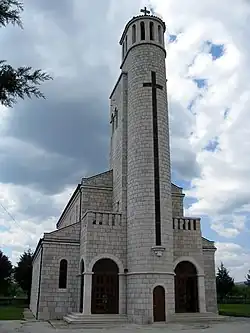Dicmo
Dicmo is a municipality in Croatia in the Split-Dalmatia County. It has a population of 2,802, 98% of which are Croats (2011 census).[3]
Dicmo | |
|---|---|
 | |
 | |
 Dicmo | |
| Coordinates: 43°38′N 16°35′E | |
| Country | |
| Historical region | Dalmatian Hinterland |
| County | |
| Area | |
| • Total | 69.0 km2 (26.6 sq mi) |
| Population (2021)[2] | |
| • Total | 2,805 |
| • Density | 41/km2 (110/sq mi) |
| Time zone | UTC+1 (CET) |
| Website | dicmo |
Geography and history
Dicmo is a municipality made up of small villages located on the bottom of several foot-hills and edges of a stretched karst field, connected via the D1 road in the middle of the field, with Sinj 10 km to the north, A1 Motorway 7 km to the south and Split 20 km to the south-west.
Dicmo has been inhabited since the Ilyrian ages, but the first mentions of it and its name comes from the word "Decimanum", because it was the "tenth mile" on the ancient road between Salona and Aequum. Throughout its history, Dicmo has been a transit stop for both commercial and military reasons, and like the rest of today's Croatia, often changed administrations, due to both the Ottoman and Morean wars. During the Austro-Hungarian rule, a railway between Sinj and Split, "Rera", whose route passed through Dicmo is built. World War II came up and Dicmo was once again a transit route, this time for Italians and Germans on their path to Split, which allowed Italians to build a watchtower next to the local train station, the ruins of which can be seen to this day. At the beginning, there was a mix of sides, but after 1943, residents joined the fight against Axis powers. Notable WW2 event in the municipality took place in the Butige hamlet where several Ustaše soldiers were intrcepted by Sinj partisans and eventually taken into Huso's pit (Husina jama), a mt. Kamešnica site where dozens of axis bodies were disposed. During the Yugoslav era, the area was under a former municipality of Sinj, during which the Rera railway was shut down, D1 road was built in the 1960s, while the electricity and the waterlines were installed in the 1970s and late 1980s, respectively. Many inhabitants of the municipality took part in the Croatian War of Independence, after which Dicmo became a part of Croatia and a municipality in the Split-Dalmatia county, with the HDZ (Croatian Democrat Party) as a local leading political party. Most notable investment during the 21st century, during the ruling of the independent political party, is the municipality's Industrial Zone, with over 500 people from the nearby region employed in it.
Education
Osnovna škola Ante Starčevića Dicmo (Ante Starčević elementary school)
Sports
MNK Spartak (Futsal Club Spartak)
Notable people
- Michael Anthony Bilandic, former Chicago mayor (parents were immigrants from Krušvar)
- Ratko Rudić, waterpolo coach
- Ivan Grubišić, Catholic priest, politician, sociologist
- Bruno Silić, waterpolo coach
- Inoslav Bešker, journalist
References
- Register of spatial units of the State Geodetic Administration of the Republic of Croatia. Wikidata Q119585703.
- "Population by Age and Sex, by Settlements, 2021 Census". Census of Population, Households and Dwellings in 2021. Zagreb: Croatian Bureau of Statistics. 2022.
- "Population by Ethnicity, by Towns/Municipalities, 2011 Census: County of Split-Dalmatia". Census of Population, Households and Dwellings 2011. Zagreb: Croatian Bureau of Statistics. December 2012.
